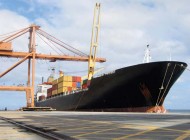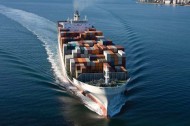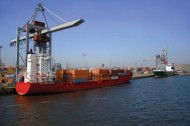 As countries around the world impose increasingly stringent import compliance regulations on global supply chains, Xenos, the market-leading provider of high-performance software solutions that deliver a superior Return on Information™ by Streamlining Enterprise Information Supply Chains™, is coming to the fore in facilitating the timely, accurate exchange of shipping and transport information between trading partners and, crucially, ports. There is little or no tolerance for errors or bottlenecks in dealing with port authorities: anything not immediately corrected can result in costly delays, fines or potential closures for transportation companies and their customers and trading partners.
As countries around the world impose increasingly stringent import compliance regulations on global supply chains, Xenos, the market-leading provider of high-performance software solutions that deliver a superior Return on Information™ by Streamlining Enterprise Information Supply Chains™, is coming to the fore in facilitating the timely, accurate exchange of shipping and transport information between trading partners and, crucially, ports. There is little or no tolerance for errors or bottlenecks in dealing with port authorities: anything not immediately corrected can result in costly delays, fines or potential closures for transportation companies and their customers and trading partners.
Growing numbers of forward-thinking companies in international supply chains are embracing Xenos’ “transformation” technology to receive EDI data and output it in the required language and format for use by their trading partners and port authorities. Xenos’ high-performance Data and Document solutions enable Xenos’ customers to process and transform their supply chain data and documents so they are available when, where and how they are needed, and any problems can be resolved quickly. Jeff Mills, EMEA Managing Director of Xenos, spoke to Warehouse & Logistics News.
Warehouse & Logistics News – First of all, Jeff, can you sum up what your applications do?
Put simply, our server-based technology provides a centralised process for capturing the organisation’s internally generated shipping data or its trading partners’ shipping data, and transforming it for delivery to other trading partners. Our data transformation applications streamline clients’ information supply chains without the need to re-engineer the whole system, by transforming structured and unstructured information into the desired form.
 WLN – In non-technical terms, do your applications in effect save data files into documents which can be transmitted in a form other people’s systems can open and read?
WLN – In non-technical terms, do your applications in effect save data files into documents which can be transmitted in a form other people’s systems can open and read?
Yes, they do. The repurposing of data is one of our core functionalities: our applications can take any data and transform it into any shape anyone else needs. We try to be application agnostic and build as open a system as possible.
WLN – Do other people in the chain need a Xenos application on their system to open received files?
Generally they don’t. Our technology delivers information in any form wherever it may be required, unless it needs to be sent securely over the Internet, in which case the client needs a piece of software based on ebXML. This is an open XML-based standard sponsored by OASIS, the Organisation for the Advancement of Structured Information Standards, an international not-for-profit open standards global information society, and UN/CEFACT, the UN centre for trade facilitation and electronic business.
WLN – Are we talking about applications that transform files into documents that can be emailed to others, or applications that enable various parties to access and transform data held on the web – the centralised repository in your previous answer – into files they can download at the port of entry and so on?
Our technology offers both opportunities – a central repository, or sending by different channels: email, mobile text, FTP and HTTP.
 WLN – What specific data transformation applications do you offer for shipping and transportation? What do people use them for?
WLN – What specific data transformation applications do you offer for shipping and transportation? What do people use them for?
Xenos Enterprise Server is the overarching product that delivers the data and document transformation services in our shipping and transportation solution. At one time our Data Transformation Service was also known as TerminalONE Transform, a name some readers will recognise. It is one of the technologies at the core of Xenos Enterprise Server.
One of our clients, the Port of Rotterdam, uses Xenos Enterprise Server to transform and ingest 1,300 different formats of data message. Xenos Enterprise Server normalises data into standard XML format and loads it into a database, which serves as the front end for interested parties to access the data on line. As part of this, documents pass from ship to shore in minutes.
WLN – When was Xenos founded? Who owns the company now?
Stu Butts, our CEO, founded Xenos in Toronto about 30 years ago. The company was listed on the Toronto Stock Exchange in 1999.
 WLN – How big is Xenos worldwide in turnover and staff? How many countries do you operate in? Do you have formal links with any other software or hardware houses?
WLN – How big is Xenos worldwide in turnover and staff? How many countries do you operate in? Do you have formal links with any other software or hardware houses?
Xenos has a global revenue of 16m Canadian Dollars (CAD) and growing. We have 90 staff and operate directly in North America and Europe as well as through resellers elsewhere around the world. We have formal links with many software companies including IBM, EMC, Oracle and CA.
WLN – Where do you develop your applications? Where is your European centre of operations?
We do most of our software development at our global HQ in Toronto. Our European HQ is in Walton on Thames, Surrey. We have a highly experienced professional services group in the UK that performs research and builds specific applications for our European customers.
 WLN – What other industry sectors besides shipping and transportation do you supply data transformation solutions for?
WLN – What other industry sectors besides shipping and transportation do you supply data transformation solutions for?
We are also strong in banking, insurance, finance, healthcare, telecoms and government. The Norwegian government uses our solution to deliver patients’ information electronically between doctors, hospitals and pharmacies and to and from the government. We had the system up and running in a matter of months.
WLN – Where do you rank among suppliers of these applications for shipping and transport?
We’ve been involved with shipping and transportation as a sector for a long time, but we’ve become particularly active over the last couple of years.
WLN – Why buy a transformation solution from Xenos?
We are a market leader in our area, and the only company that can deliver a solution taking data and documents from anywhere and delivering it to any device or channel and in any format needed.
You can buy our technology at modular level, to process one type of information initially, and grow the system strategically to take any kind of information from any amount of people and send it to a wide number of recipients. As part of the information delivery you may also want to send a human readable format such as PDF – our technology can also produce that type of data.
WLN – As EMEA MD, what does your day-to-day role involve?
It varies. I have to keep an eye on sales, professional services, support, marketing and PR but I also strongly believe in seeing customers as often as possible. I spend a fair amount of my time in the office in Walton on Thames and the rest travelling throughout the EU and beyond. We have another office in France plus a wide range of resellers in continental Europe as well as customers from Finland to South Africa within this region that all need attention.
WLN – How are you set up to market your shipping and transport solutions?
As well as selling direct to the ports community we have a number of partnerships with specialist IT vendors that service that industry with applications such as location asset management.
WLN – When did you start trading here?
We started trading here as Xenos Europe in 1999, before that we were a Xenos reseller covering the UK only.
WLN – What distinguishes the UK as a market for your shipping and transport applications? How do we rate in adopting transformation technology in shipping and transportation?
The UK is characterised by having a handful of operators each controlling several ports, which has a bearing on how we approach them. We are currently in conversations in the UK assessing the potential opportunity.
WLN – Focusing on your shipping and transportation business, how do your applications transform the way air and seaports operate?
Our solutions automate ports’ manual documentation processes and speed up customs clearance and increase traffic and volume using their existing IT. They automate acceptance of data between vessels and port authorities, extracting key information, transforming it into the data format required and securely delivering that data in real time.
WLN – How much does this speed up a port’s day-to-day working?
Taking Rotterdam as an example, we sped up the processing of information for ships coming to shore from 10 hours to 20 minutes. A container ship on its way to port has to give specific information about its cargo to the port, to Customs and Excise, to the logistics companies transporting the goods onwards and to other people such as vets if it’s carrying livestock. The process relied on human intervention; now it’s automatic and people can see from the web-based front end what needs to be done. The IT resides in the port’s IT section: ships send messages as before: suppliers and on-shore logistics people don’t need to change the way they work.
WLN – Which ports are currently using your applications?
Ports using our technology include Rotterdam, Europe’s biggest deepwater port, Karachi, Pakistan’s largest port, Vancouver, New Jersey and various ports in California. They all use our technology in similar ways, automating manual documentation processes, speeding up clearance and increasing traffic.
WLN – Do you have any case studies about ports and transport/shipping organisations using these applications?
We have a number of white papers and articles about our work with ports on our web site.
WLN – Are any UK ports considering adopting your technology?
We’re currently in discussion with various UK port operators. When it goes ahead, adoption is fairly quick if the port has set its mind to do it. We’re being contacted by a new port every week as people see what we’re achieving elsewhere.
WLN – Do you also offer enabling applications for EDI inside countries?
Yes, we do. Transport and logistics companies and their customers around the world are using Xenos’ solutions to automate invoice processing, transforming the difficult and time-consuming process of manually extracting key information from invoices, capturing and translating the data and delivering it to their EDI systems for onward transmission in the supply chain.
In the US for example, Boyle Transportation extract shipping information from their database to create EDI data which is forwarded, interfacing with their tracking system. Internal departments are alerted to receive invoices, listen for acknowledgements and populate a database with orders coming up.
WLN – Electronic data interchange has been in everyday use in retail supply chains in the UK for quite a while now. Have you been part of that story?
Yes, we have. Among other customers we provided a solution to a major retailer in Scotland. EDI was one of several function areas.
WLN – What form do ports generally want shipping information supplied in?
Generally they want a single standard format: most ports have opted for XML, one of our systems’ key outputs. The great thing with our system is that a port does not have to ask all their partners to change their systems, as the Xenos solution accepts any format.
WLN – Can the output for your applications be ‘read’ by everyone in ports and transportation around the world?
Yes, absolutely – because of the huge variety of formats it can handle, anyone can use it in any form to put information through.
WLN – In EMEA, who are your data transformation clients in the shipping and transportation sectors?Do you also supply your shipping and transportation applications to manufacturers and retailers?
So far we supply various ports and the Scottish retailer, as I’ve mentioned. We aren’t working with any FMCG manufacturers yet, but we have doors open there and in other industry sectors. People might be surprised to learn how affordable our solutions are.
WLN – How many different EDI standards/protocols/languages are there?
There are many different standards and EDI formats because in implementing them, everyone finds they need to adjust the standard slightly to better suit their needs. Most applications in a company are not written to read EDI, so you need an IT ‘layer’ to transform the data from the back office system.
WLN – It’s probably a stupid question, but why isn’t there a single world EDI protocol for shipping and transport by now?
It’s not happened because there are so many different systems for different areas. You’d never get a single protocol because there are too many parties involved that have slightly different needs, but the good news is, we enable customers to speak to all of them.
WLN – What does a Xenos shipping or transport solution for a specific company incorporate?
Xenos’ transport and shipping applications involve everything you need to get information from the trading partner to the back end applications. This includes secure transportation from the trading partner, routing, auditing, translation and integration with all the various systems without human intervention.
WLN – Who in a client organisation would use your solutions in their daily work – what jobs would they have? Who would make the buying decision?
Within the port community, users would be anyone who needs to access information about ships coming to shore, from harbour masters to customs people. Decision makers include chief information officers, chief technical officers, enterprise architects, business managers and operations managers. We’re actively feeding information to these people at the moment.
WLN – How long does it take from go ahead to go live?
After we agree on the specification with the customer it can take either days or months, depending on the complexity of the process they want and the delivery to be achieved. Some customers buy the base solution and implement it themselves, for others we do the complete design and build. We train customers’ staff and provide a dedicated support team, after which we hand the system over. The most important part of the process is sitting and listening to the customer’s requirements.
WLN – Finally, where do you see Xenos’ shipping and transportation solutions going from here?
Looking forward I see us doing extremely well. Any port of a significant size needs this technology to survive and outflank the competition. It offers a means to unite ports even more tightly with their partners and suppliers so information is automatically assessed and analysed and decisions made without human intervention and possible error, or information passed on to decision makers as a matter of urgency.
Despite the global recession, we continue to grow. The business benefits of our solutions are encouraging people to explore non-traditional approaches to their traditional business problems.
Xenos Europe Ltd tel: 01932 252 299 www.xenos.com




Comments are closed.